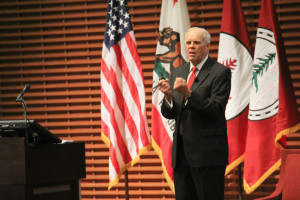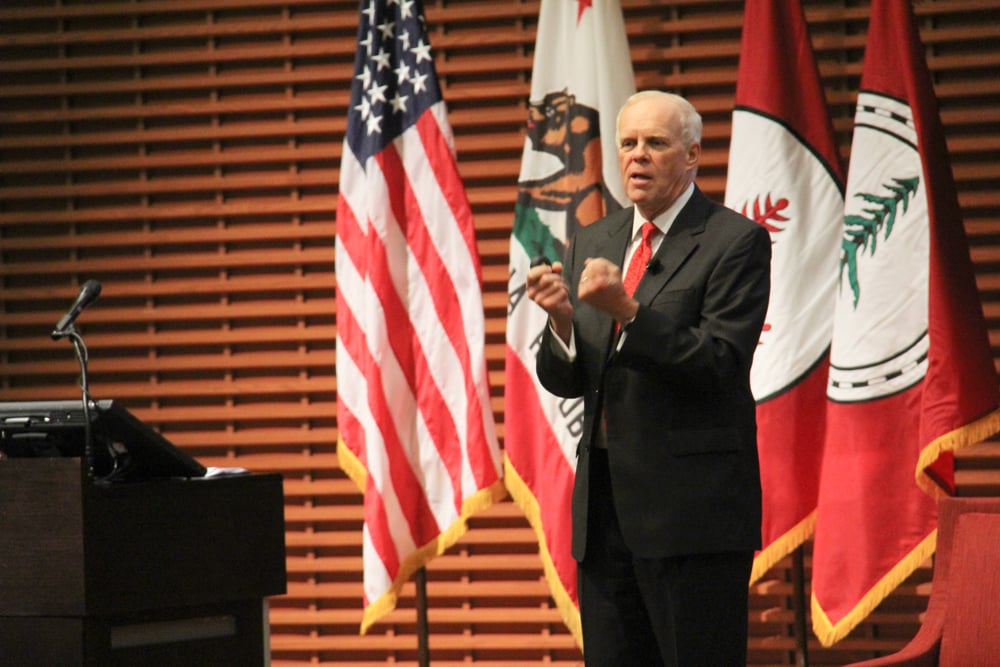President John Hennessy focused on sustainability in his annual address to the Academic Council, which he delivered Thursday afternoon in CEMEX Auditorium.
“Good sustainability practice begins with not wasting, whether it’s not wasting food, not wasting energy, not wasting water, and it’s the action of all of us as individuals that really contributes to that,” Hennessy said. “I think we want to be a model for the community — we want to show that we can operate this university well.”

Hennessy covered topics related to connections across academic disciplines, faculty accomplishments, admissions results and construction on campus before turning to the main emphasis of his presentation: Stanford’s previous and ongoing initiatives to improve sustainability on campus.
He was joined onstage by Pamela Matson, dean of the School of Earth Sciences; Shirley Everett, senior associate vice provost of Residential & Dining Enterprises (R&DE); Joseph Stagner, executive director of sustainability and energy management; and Fahmida Ahmed, associate director of sustainability and energy management.
The panel discussed major initiatives such as the Y2E2 building, the University’s long-term water and energy plans, and the “Love Food, Hate Waste” campaign that is part of R&DE’s sustainability work.
According to Hennessy, the construction of the Y2E2 building — which opened in 2008 and has the highest possible LEED certification — marked a watershed moment for Stanford’s commitment to sustainability.
He noted that the new efficiency standards for Y2E2 set a precedent for other buildings on campus — particularly the new business school campus — and emphasized that even though the buildings are efficient, they are also attractive and function well.
“This sends a message to the whole community that you can be sustainable and still have great-looking buildings that are terrific to work in,” Hennessy said. “I think that’s an important message to send not only to campus but also send to the broader community.”
Stagner reported on the progress of the Stanford Energy System Innovations (SESI) project, which is projected to be one of the most energy-efficient university systems in the world once fully implemented in April 2015.
“When this plan is complete, we’ll be moving off fossil fuel — natural gas, as it were — directly on campus, and we’ll have an almost all electric campus fueling our energy with heat recovery,” Stagner explained.
Stagner also discussed an effort to make water usage on campus more sustainable by accessing groundwater that flows approximately 100 feet below campus.
“It’s a sustainable resource that is available and being underutilized right now,” Stagner said. “We conducted engineering studies…and determined that we could probably sustainably take water from the Stanford lands without depleting the reservoirs, and that amount of water could be more than 50 percent of our current use.”
However, Stagner noted that shifting to groundwater from the pristine mountain water could change the chemistry of the water and potentially affect lab work. He said that over the next few months, the water department will analyze the effect on researchers and determine how to mitigate these concerns.
On a more individualized level, Everett described R&DE as working to ensure that its operations — which serve over 6 million meals annually — are also sustainable.
“When we think of sustainability, we want to make sure that we are sourcing locally, organically, humane, fair-trade, family-owned and from sustainable fisheries,” Everett said. “We want to make sure that we offer food from any of those venders that we work with that respect their land and their workers.”
Everett also discussed the ways in which R&DE tries to induce patrons to eat less food, such as by eliminating trays, reducing plate size and even forcing students to scrape their own trays in order to make them aware of their waste.
Other plans to improve campus sustainability include a campus-wide electric car charging network and collaboration across academic departments to promote food security, as well as the establishment of on-campus gardens.
“[Sustainability] is the goal of meeting the needs of people — our needs for food and energy and water and shelter and education and employment and everything else — while at the same time protecting and sustaining the life support systems of the planet,” Matson said. “The focus here is intergenerational — meeting our needs as well as those of our children and grandchildren. And really what better place to focus on that than at a university like ours? Because it’s our business to be teaching and carrying out research.”
Contact Jana Persky at [email protected].
